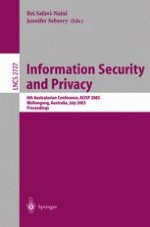2003 | Buch
Information Security and Privacy
8th Australasian Conference, ACISP 2003 Wollongong, Australia, July 9–11, 2003 Proceedings
herausgegeben von: Rei Safavi-Naini, Jennifer Seberry
Verlag: Springer Berlin Heidelberg
Buchreihe : Lecture Notes in Computer Science
Enthalten in: Professional Book Archive
